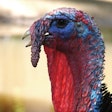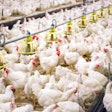
Despite the swift implementation of control measures following suspicions of highly pathogenic avian influenza (HPAI), South Korea continues to report new HPAI outbreaks linked to the H5N1 virus variant.
Since the virus reemerged among the country’s poultry flocks in mid-October, three outbreaks have been confirmed to the World Organisation for Animal Health (WOAH).
According to the agriculture ministry, the nation’s outbreak total currently stands at 13, with cases in five provinces.
Affected so far have been five farms with meat ducks, while other outbreaks have involved laying hens, broilers, breeders and quail.
Facing a deepening HPAI crisis, the agriculture minister announced measures last week increasing the intensity of preventative culling of poultry following confirmed cases.
Where the HPAI risk is particularly high, all poultry within 500 meters of an outbreak are to be culled. This also applies to all domestic poultry other than broilers in a radius of 500 meters to one kilometer. It covers the area around Cheongju (south-central province of North Chungcheong), where a number of the recent outbreaks have occurred, as well as in areas attracting migrating birds.
For all other areas of South Korea, all poultry within 500 meters of a confirmed outbreak will be culled, while all ducks will be slaughtered within a one-kilometer radius of the infection.
These changes came into effect at the end of last week. Also being stepped up are testing of poultry, and inspections of poultry farms to ensure that biosecurity measures are being implemented correctly and rigorously.
Japan confirms five farm outbreaks
At the end of October, Japan’s first HPAI cases of the 2022-2023 season were confirmed by the agriculture ministry.
So far, the authorities have officially confirmed five outbreaks in commercial poultry with WOAH. These have involved a total of almost 1.94 million poultry — four flocks of laying hens, and one of broiler chickens. The outbreaks are not confined to one area of Japan. They have affected different prefectures ranging from the northernmost main island of Hokkaido to Shikoku off the southern coast of Honshu.
Since November 2, four further outbreaks have been confirmed by the agriculture ministry.
These latest cases involve around 150,000 broilers in Hokkaido, 34,000 laying hens in Okayama prefecture (western Honshu), and a small mixed flock in south-central Honshu. Last outbreak to be confirmed was in a flock of 44,000 laying hens in Hyogo. This ninth outbreak brings to six the number of Japanese prefectures with one or more HPAI cases confirmed since the end of October.
India reports avian flu in poultry in southern state
In the Alappuzha district of Kerala, more than 2,000 of the 18,000 poultry in two flocks died around one month ago. According to the recent WOAH notification, the symptoms were observed in ducks.
Previously, the H5N1 HPAI virus was most recently detected in the state back in September of 2020, according to the report. However, 20 outbreaks involving more than 169,000 of the state’s poultry were officially registered with WOAH in the months of November and December last year.
More recently, Onmanorama has reported that 8,000 ducks in a third Alappuzha village are scheduled for culling. They are located within one kilometer of dead birds that tested positive for the HPAI virus. Since the end of October, it reports, almost 20,500 poultry have been culled in two other villages following similar findings.
HPAI returns to Russia’s Far East
Following a two-month hiatus, the H5N1 HPAI virus has been detected again in the Khabarovsk region in the Far Eastern federal district.
At the end of October, more than 66,000 of the 523,000 birds on a commercial farm died, according to the WOAH report.
Around the same time, some of the 227,000 poultry at a farm in the Sakhalin region tested positive for the same virus variant. There, more than 19,000 birds died, and 41,000 were destroyed.
Located off the coast of eastern Russia, Sakhalin is an island lying north of the Japanese archipelago.
HPAI-related losses reported in Vietnam
So far this year, more than 93,000 poultry have been culled in Vietnam due to HPAI. This is according to Chinese news agency Xinhua. Citing Vietnamese media, it reports that in 21 provinces/cities of Vietnam, 40 outbreaks linked to the H5N1, H5N6, and H5N8 virus variants have been confirmed so far this year.
In the coming months, local authorities in Vietnam have warned of a higher risk of outbreaks. This is a result of more favorable weather conditions for the virus to survive and spread, as well as a decline in poultry vaccination rates, reports Xinhua.
Vietnam’s animal health agency has recently registered with WOAH 13 new HPAI outbreaks linked to the H5N1 virus serotype.
Avian flu resolved in Afghan, Nepali poultry
Earlier this month, veterinary authorities officially declared the disease situation closed in their respective countries.
In Afghanistan, an H5 HPAI virus was detected for the first time in poultry back in January of 2018. Affected in the only reported outbreak was a flock of 54,000 domestic birds, according to the notification to WOAH. As no further cases were found, the situation was described as “resolved” in September of the following year.
To WOAH, Nepal’s veterinary authority reported 34 HPAI outbreaks involving the H5N1 virus serotype between January and June of 2022. Directly impacted through mortality or culling were around 275,000 poultry in four regions — Eastern, Central, Mid-Western, and Western. The national agency has recently declared the disease series “closed.”
HPAI situation in Asian wild birds
For the first time ever, the H5N2 serotype of the HPAI virus has been detected in Japan.
At the end of October, a wild crow tested positive for this virus in Sapporo on the northernmost island of Hokkaido, according to the WOAH notification.
Meanwhile, on Japan’s main island, Honshu, three more wild birds at different locations have tested positive for the H5N1 HPAI virus.
In western Asia, earlier outbreak series have officially been declared closed in Afghanistan and Kazakhstan.
Based on previous notifications to WOAH, a number or rooks in Afghanistan tested positive for an H5 HPAI virus at the end of 2017. By September of 2019, the disease situation was considered to be ”resolved.”
In June of this year, two wild birds found dead in the Caspian Sea tested positive for a virus of the same HPAI family, according to Kazakhstan’s veterinary authority. With no further cases detected subsequently, the disease series was considered closed the following month, according to a recent WOAH notification.
View our continuing coverage of the global avian influenza situation.

















